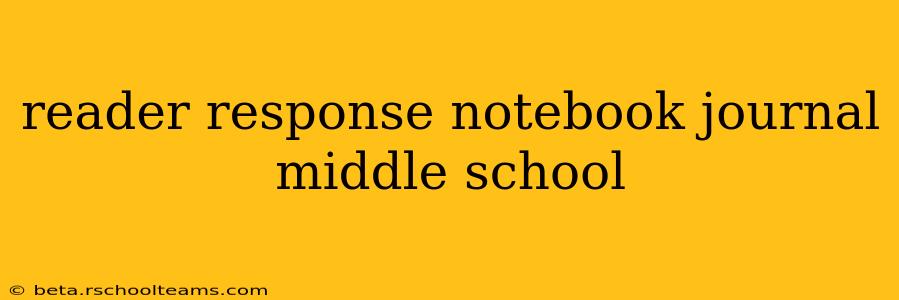Middle school is a pivotal time for developing critical thinking skills and a lifelong love of reading. A reader response notebook is a powerful tool to achieve both. It’s more than just a diary of your reading experiences; it's a dynamic space for engaging with texts on multiple levels, fostering deeper understanding and analytical prowess. This guide explores how to effectively use a reader response notebook to enhance your middle school reading journey.
What is a Reader Response Notebook?
A reader response notebook is a personalized journal where you record your thoughts, feelings, questions, and analyses as you read. It's not about summarizing the plot; it's about actively engaging with the text on an intellectual and emotional level. Think of it as a conversation you're having with the author and the characters, a space for exploring your personal interpretations and connections.
How to Use a Reader Response Notebook: Tips and Techniques
1. Setting it Up:
Choose a notebook you enjoy using – size, style, and binding are all personal preferences. Consider adding dividers to separate different books or units of study. Numbering pages is helpful for easy referencing.
2. Responding to the Text:
- Annotate Directly: Don't be afraid to write directly in your book! Underline key passages, highlight important quotes, and jot down initial reactions in the margins.
- Record Your Initial Reactions: What's your first impression of the book? Do you connect with any of the characters? Are there any passages that particularly grab your attention?
- Pose Questions: Asking questions is crucial. What puzzles you? What do you want to know more about? What are the underlying themes or messages?
- Make Connections: Connect the text to your personal experiences, current events, or other books you've read. These connections deepen your understanding and make the reading more meaningful.
- Explore Themes and Motifs: Identify recurring ideas or symbols and analyze their significance to the overall narrative.
- Analyze Character Development: How do characters change throughout the story? What motivates their actions?
- Evaluate Writing Style: Pay attention to the author's word choice, sentence structure, and overall style. How does the writing contribute to the overall effect of the story?
3. Beyond Summaries:
Avoid simply summarizing the plot. Your entries should reflect your critical engagement with the text. Consider these types of entries:
- Character Sketches: Draw a character and list their key traits, motivations, and conflicts.
- Dialogue Reconstruction: Imagine a conversation between two characters that wasn't explicitly written.
- Alternative Endings: How would you have ended the story?
- Creative Writing Prompts: The text can inspire your own creative writing. Try writing a poem, a short story, or a song inspired by the book.
Common Questions About Reader Response Notebooks
What kind of notebook should I use? Any notebook you find comfortable to write in will work! Some students prefer spiral notebooks, while others prefer journals with blank pages or lined pages. Experiment to find what best suits your style.
How often should I write in my notebook? Aim for regular entries, even if they are short. Writing immediately after reading a chapter or section can help capture your initial thoughts and reactions.
What if I don't understand something in the book? That's perfectly fine! Writing down your questions and uncertainties is part of the process. You can then seek clarification from your teacher, a classmate, or even through online research.
Is there a right or wrong way to use a reader response notebook? No! The most important thing is to be honest and reflective in your writing. Your notebook is your personal space to explore your thoughts and reactions to the books you read.
Reader Response Notebooks: A Journey of Discovery
Using a reader response notebook is a journey of self-discovery as much as it is a journey of literary exploration. It allows you to become a more active and engaged reader, sharpening your analytical skills and fostering a deeper appreciation for literature. Embrace this powerful tool, and watch your reading comprehension and critical thinking abilities soar. Your future self will thank you!
